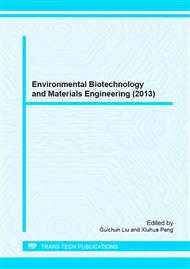[1]
K. Bernat, I. W. Baryla and A. Dobrzynska. Denitrification with endogenous carbon source at low C/N and its effect on P(3HB) accumulation, Bioresource Technology, Vol. 99 (2008) No. 7, P. 289.
DOI: 10.1016/j.biortech.2007.05.008
Google Scholar
[2]
Z. Abu-Ghararah and C. Randall. The effect of organic compounds on biological phosphorus removal, Water Science & Technology, Vol. 23 (1991) No. 4-6, P. 585.
DOI: 10.2166/wst.1991.0508
Google Scholar
[3]
P. Elefsiniotis, D.G. Wareham and M.O. Smith. Use of volatile fatty acids from an acid-phase digester for denitrification, Journal of Biotechnology, Vol. 114 (2004) No. 3, P. 289.
DOI: 10.1016/j.jbiotec.2004.02.016
Google Scholar
[4]
P.J. Strong, B. McDonald and D.J. Gapes. Enhancing denitrification using a carbon supplement generated from the wet oxidation of waste activated sludge, Bioresource Technology, Vol. 102 (2011) No. 69, P. 5533.
DOI: 10.1016/j.biortech.2010.12.025
Google Scholar
[5]
G.H. Yu, P.J. He and L.M. Shao. Extracellular proteins, polysaccharides and enzymes impact on sludge aerobic digestion after ultrasonic pretreatment. Water research, Vol. 42 (2008) No. 8-9, P. (1925).
DOI: 10.1016/j.watres.2007.11.022
Google Scholar
[6]
P.M. Biradar, S.B. Roy and S.F. D'Souza: Excess cell mass as an internal carbon source for biological denitrification, Bioresource Technology, Vol. 101 (2010) No. 6, P. 1787.
DOI: 10.1016/j.biortech.2009.10.049
Google Scholar
[7]
Y. Gao, Y. Peng and J. Zhang: Biological sludge reduction and enhanced nutrient removal in a pilot-scale system with 2-step sludge alkaline fermentation and A2O process, Bioresource Technology, Vol. 102 (2011) No. 5, P. 4091.
DOI: 10.1016/j.biortech.2010.12.051
Google Scholar
[8]
APHA. Standard Methods for the Examination of Water and Wastewater 14ed: APHA American Public Health Association, (1976).
Google Scholar
[9]
X.R. Kang, G.M. Zhang and L. Chen: Effect of Initial pH Adjustment on Hydrolysis and Acidification of Sludge by Ultrasonic Pretreatment, Industrial & Engineering Chemistry Research, Vol. 50 (2011) No. 22, P. 12372.
DOI: 10.1021/ie2018838
Google Scholar
[10]
G. Ji, B. Liao and H. Tao: Analysis of bacteria communities in an up-flow fixed-bed (UFB) bioreactor for treating sulfide in hydrocarbon wastewater, Bioresource technology, Vol. 100 (2009) No. 21, P. 5056.
DOI: 10.1016/j.biortech.2009.05.052
Google Scholar
[11]
Lee SH, Chung CW, Yu YJ, et al. Effect of alkaline protease-producing Exiguobacterium sp. YS1 inoculation on the solubilization and bacterial community of waste activated sludge, Bioresource Technology, Vol. 100 (2009) No. 20, P. 4597.
DOI: 10.1016/j.biortech.2009.04.056
Google Scholar
[12]
B. Zhang, B.S. Sun and M. Ji. Population dynamic succession and quantification of ammonia-oxidizing bacteria in a membrane bioreactor treating municipal wastewater, Journal of Hazardous Materials, Vol. 165 (2009) No. 1-3, P. 796.
DOI: 10.1016/j.jhazmat.2008.10.116
Google Scholar
[13]
W.D. Tian, W.G. Li and K.J. An. Denitrifying dephosphatation performance link to microbial community structure, Journal of Water Sustainability, Vol. 1 (2011) No. 3, P. 269.
Google Scholar


